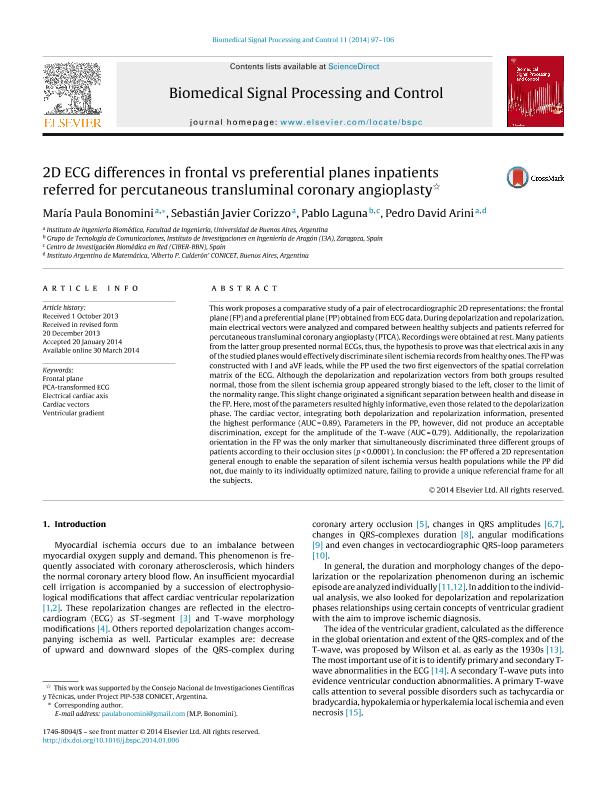Mostrar el registro sencillo del ítem
dc.contributor.author
Bonomini, Maria Paula

dc.contributor.author
Corizzo Sebastián Javier
dc.contributor.author
Laguna, Pablo
dc.contributor.author
Arini, Pedro David

dc.date.available
2018-01-11T19:22:27Z
dc.date.issued
2014-03
dc.identifier.citation
Bonomini, Maria Paula; Arini, Pedro David; Laguna, Pablo; Corizzo Sebastián Javier; 2D ECG differences in frontal vs preferential planes inpatients referred for percutaneous transluminal coronary angioplasty; Elsevier; Biomedical Signal Processing and Control; 11; 3-2014; 97-106
dc.identifier.issn
1746-8094
dc.identifier.uri
http://hdl.handle.net/11336/33019
dc.description.abstract
This work proposes a comparative study of a pair of electrocardiographic 2D representations: the frontalplane (FP) and a preferential plane (PP) obtained from ECG data. During depolarization and repolarization,main electrical vectors were analyzed and compared between healthy subjects and patients referred forpercutaneous transluminal coronary angioplasty (PTCA). Recordings were obtained at rest. Many patientsfrom the latter group presented normal ECGs, thus, the hypothesis to prove was that electrical axis in anyof the studied planes would effectively discriminate silent ischemia records from healthy ones. The FP wasconstructed with I and aVF leads, while the PP used the two first eigenvectors of the spatial correlationmatrix of the ECG. Although the depolarization and repolarization vectors from both groups resultednormal, those from the silent ischemia group appeared strongly biased to the left, closer to the limit ofthe normality range. This slight change originated a significant separation between health and disease inthe FP. Here, most of the parameters resulted highly informative, even those related to the depolarizationphase. The cardiac vector, integrating both depolarization and repolarization information, presentedthe highest performance (AUC = 0.89). Parameters in the PP, however, did not produce an acceptablediscrimination, except for the amplitude of the T-wave (AUC = 0.79). Additionally, the repolarizationorientation in the FP was the only marker that simultaneously discriminated three different groups ofpatients according to their occlusion sites (p < 0.0001). In conclusion: the FP offered a 2D representationgeneral enough to enable the separation of silent ischemia versus health populations while the PP didnot, due mainly to its individually optimized nature, failing to provide a unique referencial frame for allthe subjects.
dc.format
application/pdf
dc.language.iso
eng
dc.publisher
Elsevier

dc.rights
info:eu-repo/semantics/openAccess
dc.rights.uri
https://creativecommons.org/licenses/by-nc-sa/2.5/ar/
dc.subject
Frontal Plane
dc.subject
Pca-Transformed Ecg
dc.subject
Cardiac Vectors
dc.subject
Ventricular Gradient
dc.subject
Electrical Cardiac Axis
dc.subject.classification
Otras Medicina Básica

dc.subject.classification
Medicina Básica

dc.subject.classification
CIENCIAS MÉDICAS Y DE LA SALUD

dc.title
2D ECG differences in frontal vs preferential planes inpatients referred for percutaneous transluminal coronary angioplasty
dc.type
info:eu-repo/semantics/article
dc.type
info:ar-repo/semantics/artículo
dc.type
info:eu-repo/semantics/publishedVersion
dc.date.updated
2018-01-10T20:29:23Z
dc.journal.volume
11
dc.journal.pagination
97-106
dc.journal.pais
Países Bajos

dc.journal.ciudad
Ámsterdam
dc.description.fil
Fil: Bonomini, Maria Paula. Universidad de Buenos Aires. Facultad de Ingenieria. Instituto de Ingeniería Biomédica; Argentina. Consejo Nacional de Investigaciones Científicas y Técnicas; Argentina
dc.description.fil
Fil: Corizzo Sebastián Javier. Universidad de Buenos Aires. Facultad de Ingenieria. Instituto de Ingeniería Biomédica; Argentina
dc.description.fil
Fil: Laguna, Pablo. Universidad de Zaragoza; España. Centro de Investigación Biomédica en Red; España
dc.description.fil
Fil: Arini, Pedro David. Universidad de Buenos Aires. Facultad de Ingenieria. Instituto de Ingeniería Biomédica; Argentina. Consejo Nacional de Investigaciones Científicas y Técnicas. Oficina de Coordinación Administrativa Saavedra 15. Instituto Argentino de Matemática Alberto Calderón; Argentina
dc.journal.title
Biomedical Signal Processing and Control

dc.relation.alternativeid
info:eu-repo/semantics/altIdentifier/url/https://www.sciencedirect.com/science/article/pii/S174680941400007X
dc.relation.alternativeid
info:eu-repo/semantics/altIdentifier/doi/http://dx.doi.org/10.1016/j.bspc.2014.01.006
Archivos asociados
